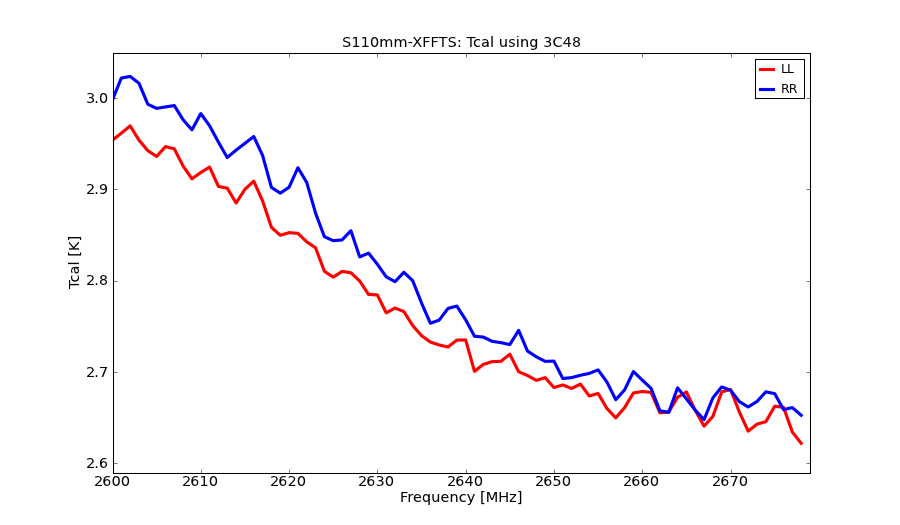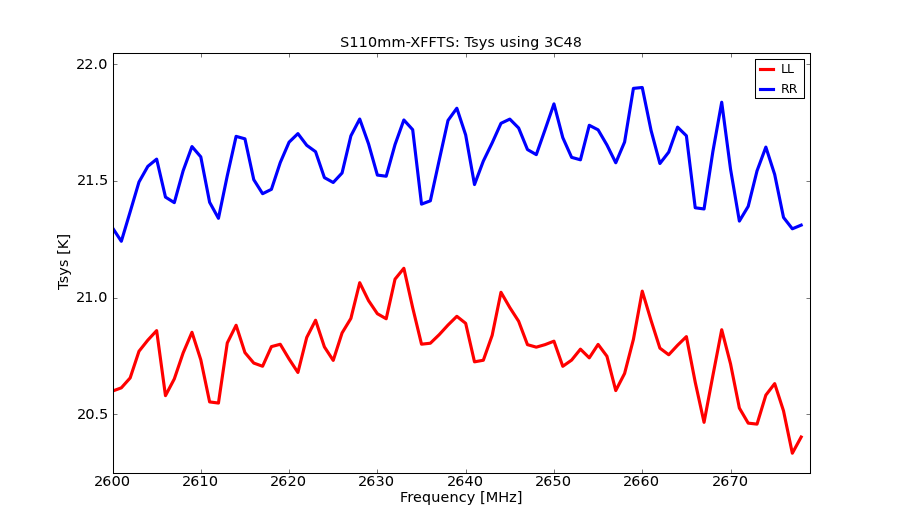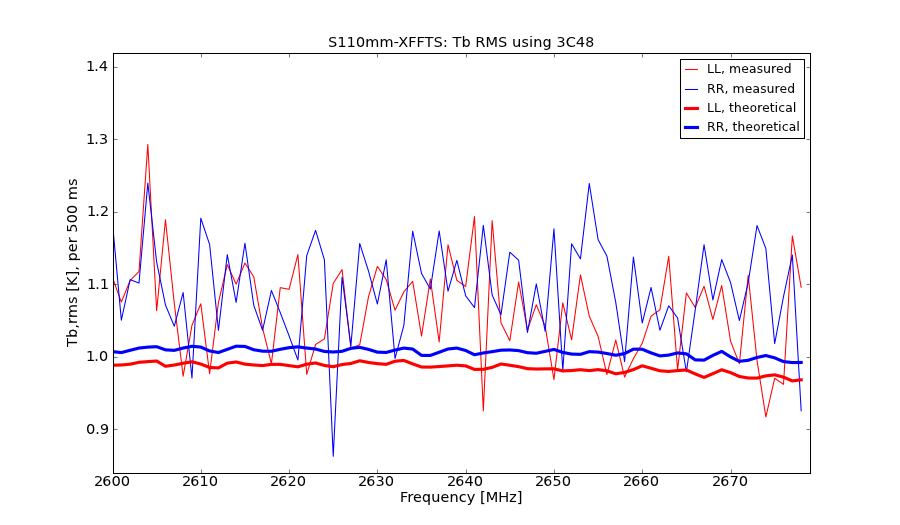Table of Contents
S110mm - 11cm secondary focus receiver (2.5-3.0 GHz)
This system is mainly used for sensitive continuum and pulsar observations. Parts this band are heavily influenced by RFI.
Overview
| RX Name | Band | Frequency range [GHz] | Polarisation | Nr. of Horns | Horn position relativ to center of focus cabin |
|---|---|---|---|---|---|
| S110mm | S | 2.5-3.0 | dual-circular | 1 | Az: 19.0 arcsec, Elv: 1593.0 arcsec |
Calibration Information
| Frequency [GHz] | Channel | Polarisation | Tcal [K] | Tsys [K] | Sensitivity [K/Jy] | SEFD [Jy] | Aperture Eff. [%] | TMB/S [K/Jy] | Main Beam Eff. [%] | FWHM [arcsec] | Last update |
|---|---|---|---|---|---|---|---|---|---|---|---|
| 2.6395 | A/B | LCP/RCP | 2.5 | 17 | 1.5 | 11 | 53 | 2.3 | 81 | 275 | Jan 2014 |
| normalized Gain curve (G = A0 + A1·Elv + A2·Elv2) | Observed in | confirmed | ||
|---|---|---|---|---|
| A0 = 1.0 | A1 = 0.0 | A2 = 0.0 | May 2024 | |
Comments:
- The values for LCP and RCP do not differ significantly.
- A typical value for the zenith opacity is < 0.01.
Available receiver versions (for OBSINP)
| Version | Description | Details |
|---|---|---|
| EDDPOL | spectro-polarimeter backend for continuum observations | |
| EDD_GSPEC | gated spectrometer | with xx channels |
| EDD_GSPEC_128k | gated spectrometer | with 128k channels |
| EDD_GSPEC_512k | gated spectrometer | with 512k channels |
| EDD_PULSAR | pulsar backend |
Below here: Information is currently updated.
Channel assignment in the MBFITS data files
Note that the narrow line and VLBA IF channels are usually only available when the specific line version of the receiver was selected. In addition for most receivers with narrow line channels the cables at the patch board need to be connected by the receiver group.
To select different channel numbers in OBSINP, the online plot, or the toolbox the numbers have to be specified like c(1)+c(2) to add channel 1 and 2. E.g. channel 1 and 2 contain the LCP and RCP broadband channels, then "OnlPlot pen='c(1)+c(2)'" or "toolbox use='c(1)+c(2)'" will select these channels. In OBSINP the pen can be directly specified in the receiver selection menu.
Abbreviations:
SB: narrow band channel (Schmalband-Kanal), 100 MHz band width
BB: digital broad band channel (Breitband-Kanal), band width varies for different receivers
VLBA: VLBA IF, 500 MHz band width
BW: band width
TP: total power
| 11cm SFK single horn receiver (multi channel polarimeter 2.595-2.675GHz) | |||
|---|---|---|---|
| Channel | IF | Pol. | Comment |
| 1 | SB | LCP | center=2.595 GHz, BW=10 MHz, TP A |
| 2 | SB | RCP | center=2.595 GHz, BW=10 MHz, TP B |
| 3 | SB | cross | center=2.595 GHz, BW=10 MHz, cos AB |
| 4 | SB | cross | center=2.595 GHz, BW=10 MHz, sin AB |
| 5 | SB | LCP | center=2.605 GHz, BW=10 MHz, TP A |
| 6 | SB | RCP | center=2.605 GHz, BW=10 MHz, TP B |
| 7 | SB | cross | center=2.605 GHz, BW=10 MHz, cos AB |
| 8 | SB | cross | center=2.605 GHz, BW=10 MHz, sin AB |
| 9–28 | … | … | continues in 10 MHz steps until |
| 29 | SB | LCP | center=2.675 GHz, BW=10 MHz, TP A |
| 30 | SB | RCP | center=2.675 GHz, BW=10 MHz, TP B |
| 31 | SB | cross | center=2.675 GHz, BW=10 MHz, cos AB |
| 32 | SB | cross | center=2.675 GHz, BW=10 MHz, sin AB |
| the last 4 channels contain the total IF 2.595-2.675 GHz | |||
| 33 | SB | LCP | center=2.635 GHz, BW=80 MHz, TP A |
| 34 | SB | RCP | center=2.635 GHz, BW=80 MHz, TP B |
| 35 | SB | cross | center=2.635 GHz, BW=80 MHz, cos AB |
| 36 | SB | cross | center=2.635 GHz, BW=80 MHz, sin AB |
Spectroscopy modes and resolution
| BW | nchan | nu | Df | Dv | dv |
|---|---|---|---|---|---|
| MHz | MHz | kHz | km/s | km/s | |
| 100 | 32768 | 2600 | 3.1 | 0.352 | 0.408 |
BW … band width
nchan … number of spectral channels
nu … center frequency
Df … Channel separation (in frequency)
Dv … Channel separation (in velocity)
dv … Velocity resolution (dv=1.16*Dv)


